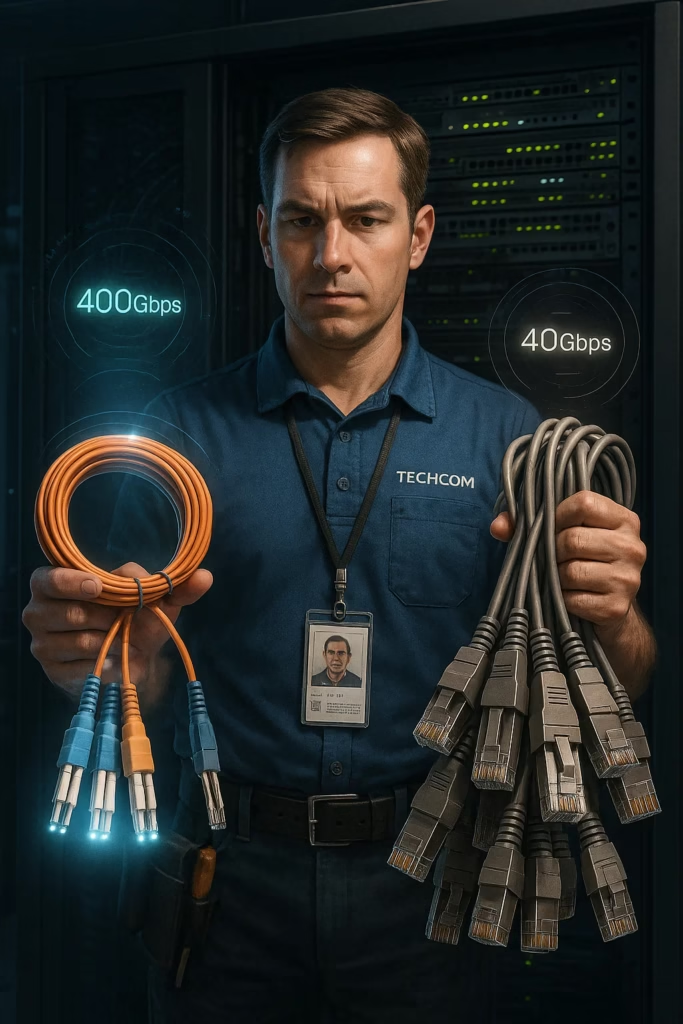Optical and copper interconnection technologies represent two distinct approaches to data transmission, each with its own advantages and limitations. While fiber optics dominate in performance, copper retains its technical and economic justification. Let’s take a deeper look at their characteristics, physical principles, and practical challenges.
Ethernet and Data Transmission: From Packets to Errors
Ethernet communication relies on packet-based transmission with built-in error detection and correction mechanisms (e.g., CRC, FEC). The key challenge in digital transmission is maintaining sufficient signal-to-noise ratio (S/N) and minimizing bit error rate (BER).
- Copper cables suffer from:
- Frequency-dependent attenuation – At high frequencies (>1 GHz), copper acts as a waveguide, leading to significant signal loss (skin effect, dielectric losses).
- EMI and crosstalk – Increased susceptibility to electromagnetic interference requires precise shielding (e.g., Cat 8 uses SF/FTP construction).
- Need for repeaters – Over longer distances (>100m for 10Gbps), signals must be regenerated (amplified) to maintain integrity.
- Fiber optics offer:
- Minimal attenuation (~0.2 dB/km for SMF vs. ~30 dB/km for copper at 1 GHz).
- Immunity to EMI – Signals travel photonicly, not electrically.
- Higher S/N and lower BER – Thanks to a cleaner medium, optical systems exhibit orders of magnitude fewer errors.
Physical Principles: Why Fiber Wins in Bandwidth
Copper has fundamental limitations due to:
- Capacitive and inductive dispersion – Higher frequencies exacerbate losses.
- Nyquist criterion and Shannon limit – Copper’s theoretical max is ~40 Gbps (Cat 8, 2 GHz, 30m), while fiber easily achieves terabits.
Fiber leverages:
- Multi-mode (MMF) and single-mode (SMF) fibers – SMF enables longer distances (100km+ without regeneration).
- DWDM (Dense Wavelength Division Multiplexing) – Multiple wavelengths in one fiber (e.g., 160 channels x 100Gbps = 16 Tbps).
Practical Challenges: Where Copper Still Leads
Despite fiber’s superior performance, practical hurdles remain:
Fiber Termination and Splicing
- Complex fusion splicing – Requires precision equipment (fusion splicer) and a clean environment.
- Connector losses – Each mechanical splice (e.g., SC/APC, LC/UPC) adds attenuation (~0.3 dB per connection).
- Fragility – Fibers demand careful handling during installation.
Economic and Logistics Factors
- Copper is cheaper for short runs – Cat 6A/Cat 8 suffice for 10Gbps/40Gbps at 30-100m in offices.
- Power over Ethernet (PoE) – Copper delivers power (up to 90W with PoE++), while fiber requires hybrid cables.
Future Trends: Where Are We Headed?
- Silicon photonics – Optical component integration into CMOS chips (e.g., Intel, Cisco).
- Active Optical Cables (AOC) – Hybrid cables with embedded optical transceivers.
- 400G/800G Ethernet – Fiber becomes the data center standard.
Optical computing as the next frontier
In the mid-term, advances in optical computing (photonic processors, optical memory) could reduce reliance on electrical-optical conversion. If data processing and storage fully migrate to the optical domain, copper’s role in data transmission may diminish—though it will remain critical for power delivery and peripheral interfaces.
Conclusion: Coexistence or Replacement?
Fiber is unmatched in performance, but copper retains niche advantages in simplicity and cost-efficiency. While fiber will dominate infrastructure (FTTH, 5G, data centers), copper remains vital for short links, PoE, and retrofits.
Long-term, photonics will likely prevail—but until then, coexistence with copper is inevitable.
What’s your take—will silicon photonics fully replace copper within the next decade? 💡


Leave a Reply